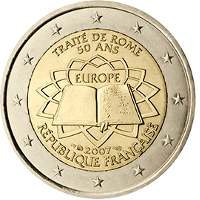 |
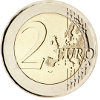 |
C o m m e m o r a t i v e
C o i n s |
||
| France | |||||||
The edge lettering on the French 2‐Euro‐commemorative coins is : |
 |
||||||
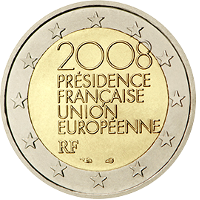 🔎
🔎 |
 |
France | 01 Jul. 2008 | French Presidency of the Council of the European Union |
20001 20002 20004 20005 |
20,084,936 |  |
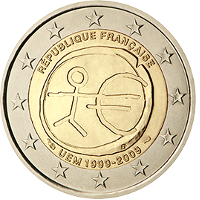 🔎
🔎 |
 |
France | 23 Jan. 2009 | 10 years of Economic and Monetary Union (EMU) |
20001 20002 20005 |
10,074,085 |  |
National characteristics : Above is the name of the issuing country "RÉPUBLIQUE FRANÇAISE" (French Republic), the acronym of the occasion of issue below is "UEM", flanked on the left by a cornucopia, the mint mark of the French mint Monnaie de Paris in Plessac. To the right of the year "2009" is a hunting horn with the sign of the zodiac Pisces, the logo of the mint master Hubert Larivières. |
|||||||
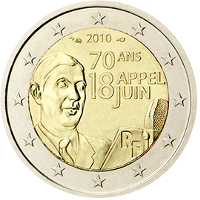 🔎
🔎 |
 |
France | 25 May 2010 | 70th anniversary of the Appeal of June the 18th 1940 by de Gaulle |
20001 20002 20005 |
20,032,000 |  |
 🔎
🔎 |
 |
France | 21 Jun. 2011 | 30th anniversary of Fête de la Musique |
20001 20002 20005 |
10,014,404 |  |
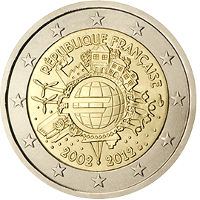 🔎
🔎 |
 |
France | 05 Jan. 2012 | 10 years Euro‐Currency |
20001 20002 20005 |
10,010,994 |  |
National characteristics : At the top of the coin is the name of the issuing country "RÉPUBLIQUE FRANÇAISE" (French Republic), followed by a cornucopia as the mint mark of the French mint Monnaie de Paris in Plessac. A pentagon, the logo of mint master Yves Sampo is to the right of the year "2012". |
|||||||
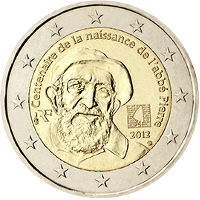 🔎
🔎 |
 |
France | 24 Jun. 2012 | 100th birthday of Abbé Pierre |
20001 20002 20005 |
1,020,000 |  |
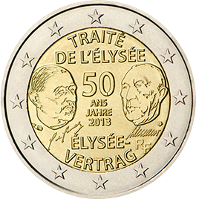 🔎
🔎 |
 |
France | 21 Jan. 2013 | 50 Years Élysée‐Treaty (Fanco‐German Friendship) Common issue of France and Germany |
20001 20002 20005 |
10,017,789 |  |
On the left of the French coin there is a cornucopia, the mint mark of the French mint Monnaie de Paris in Plessac, on the right above Adennauer's signature is a pentagon, the logo of mint master Yves Sampo and below the signature is the country abbreviation "RF" (République française, French Republic). |
|||||||
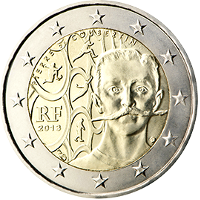 🔎
🔎 |
 |
France | 03 Jun. 2013 | 150th birthday of Pierre de Coubertin |
20001 20002 20005 |
1,014,338 |  |
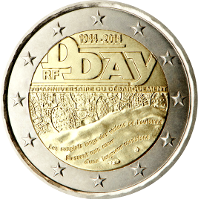 🔎
🔎 |
 |
France | 11 Jun. 2014 | 70th anniversary of the D‐Day Landings (June 6th 1944) |
20001 20002 20005 |
3,019,675 |  |
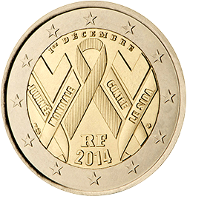 🔎
🔎 |
 |
France | 24 Nov. 2014 | World‐AIDS‐Day |
20001 20002 20005 |
3,020,000 |  |
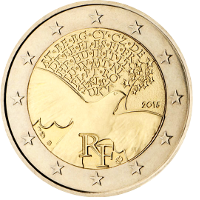 🔎
🔎 |
 |
France | 30 Jan. 2015 | 70 years of peace in Europe |
20001 20002 20005 |
4,020,500 |  |
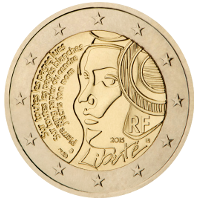 🔎
🔎 |
 |
France | 22 Jul. 2015 | 225th anniversary of Fête de la Fédération (Federation Festival) |
20001 20002 20004 20005 |
4,020,000 |  |
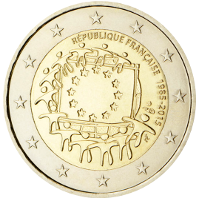 🔎
🔎 |
 |
France | 16 Nov. 2015 | 30 years EU‐Flag |
20001 20002 20004 20005 |
4,020,000 |  |
National characteristics : Above is the name of the issuing country "RÉPUBLIQUE FRANÇAISE" (French Republic), followed by the dates "1985‐2015". On the right are a pentagon the logo of mint masterYves Sampo and a cornucopia the mint mark of the French mint Monnaie de Paris in Plessac. There were 10,000 minted in the "mirror finish" and "proof" production process where the flag is coloured blue (see picture). |
|||||||
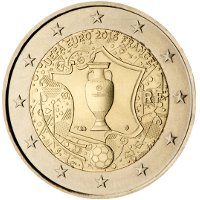 🔎
🔎 |
 |
France | 05 Feb. 2016 | 2016 UEFA European Football Championship |
20001 20002 20005 |
10,020,500 |  |
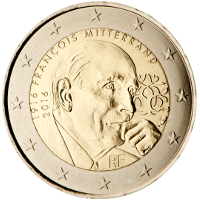 🔎
🔎 |
 |
France | 12 Sep. 2016 | François Mitterand |
20001 20002 20005 |
10,020,000 |  |
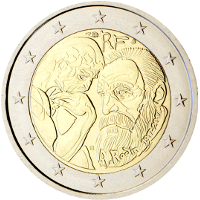 🔎
🔎 |
 |
France | 03 Feb. 2017 | Centenary of the death of Auguste Rodin |
20001 20002 20005 |
10,020,500 |  |
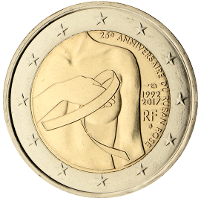 🔎
🔎 |
 |
France | 25 Sep. 2017 | 25 years of Breast cancer awareness |
20001 20002 20004 20005 |
10,020,500 |  |
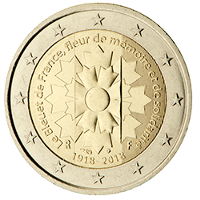 🔎
🔎 |
 |
France | 19 Feb. 2018 | "Bleuet de France" (The French Cornflower of Remembrance) |
20001 20002 20004 20005 |
15,020,000 |  |
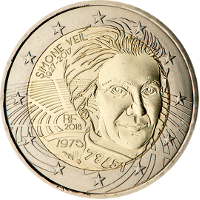 🔎
🔎 |
 |
France | 26 Jun. 2018 | Simone Veil |
20001 20002 20005 |
15,021,000 |  |
 🔎
🔎 |
 |
France | 06 Jun. 2019 | 60th anniversary of the creation of Astérix |
20001 20002 20005 |
310,000 |  |
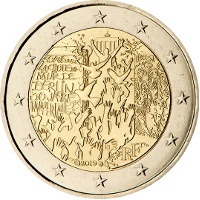 🔎
🔎 |
 |
France | 10 Oct. 2019 | 30th anniversary of the fall of the Berlin Wall Joint issue of Germany and France |
20001 20002 20005 |
15,020,000 |  |
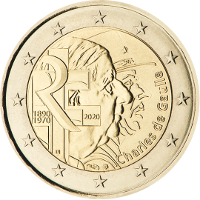 🔎
🔎 |
 |
France | 31 Jan. 2020 | Charles de Gaulle |
20001 20002 20005 |
18,061,940 |  |
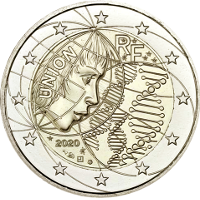 🔎
🔎 |
 |
France | 27 Oct. 2020 | Medical Research |
20002 20003 20005 |
310,000 |  |
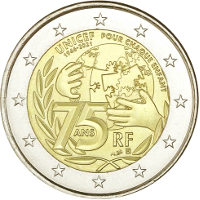 🔎
🔎 |
 |
France | 20 Feb. 2021 | 75th anniversary of UNICEF |
20002 20003 20005 |
7,520,000 |  |
 🔎
🔎 |
 |
France | 27 Sep. 2021 | Marianne and the race ‐ Eiffel Tower 1st coin in the series on the Olympic Summer Games Paris 2024 |
20002 20003 20005 |
510,000 |  |
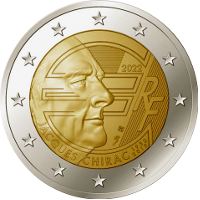 🔎
🔎 |
 |
France | 25 Jan. 2022 | 90th birthday of former President Jacques Chirac |
20002 20003 20005 |
9,020,000 |  |
 Work in progress |
|||||||
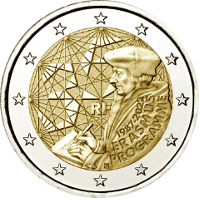 🔎
🔎 |
 |
France | 05 Jul. 2022 | 35th anniversary of the Erasmus Program |
20003 20005 20009 |
3,520,000 |  |
National characteristics : The country abbreviation "RF" (République française, French Republic) is placed centrally below the centre line. The quarter circle at the bottom right has three lines; below the commemorative period, is the issue occasion "ERASMUS PROGRAMME" (in English). At the bottom on the left sleeve is a cornucopia as the mint mark of the French mint Monnaie de Paris in Plessac on the left and the designer's signet next to it on the right. The coin is one of those with a more textured background. |
|||||||
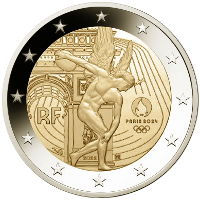 🔎
🔎 |
 |
France | 22 Sep. 2022 | The Genius and the discus throw ‐ Arc de Triomphe 2nd coin in the series on the Olympic Summer Games Paris 2024 |
20003 20005 |
260,000 |  |
 Work in progress |
|||||||
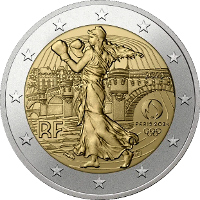 🔎
🔎 |
 |
France | 10 Jan. 2023 | The Sower and the fist fighting ‐ Pont Neuf 3rd coin in the series on the Olympic Summer Games Paris 2024 |
20003 20008 20009 |
280,000 |  |
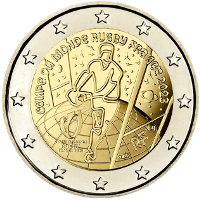 🔎
🔎 |
 |
France | 04 Jul. 2023 | Rugby Union World Cup ‐ France 2023 |
20003 20005 20009 |
15,120,000 |  |
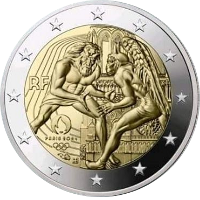
|
 |
France | 09 Jan. 2024 | Herkules and the wrestling match ‐ Notre Dame 4th coin in the series on the Olympic Summer Games Paris 2024 |
20003 | 510,000 |  |
 Work in progress |
|||||||
| References : | |||
| 20001 | Images taken with authorisation by the ECB ‐ Mail dated 20.Feb.2020 © "European Central Bank" |
20002 | Data mirrored from Wikipedia Page "2_euro_commemorative_coins" with friendly support of the guardians of that page. |
| 20003 | Images taken with authorisation by H....... Hamburg | 20004 | Coloured version of this Commemorative Coin in circulation EU‐legal‐technical specifications do not recongnise colour prints. The EU nevertheless tolerates them, as their numbers are very small and they are sold in special packs and therefor are very unlikely to be used as currency. |
| 20005 |
enlarged Images taken with authorisation by Gerd Seyffert © "Gerd Seyffert 2021" |
20006 | Not Applicable |
| 20007 | Images taken by Münzen Kreuzberg © "Münzen Kreuzberg 2021" |
20008 | enlarged Images taken by Münzen Kreuzberg © "Münzen Kreuzberg 2021" |
| 20009 | Text with kind permission by Gerd Seyffert © "Gerd Seyffert 2023" |
20010 | Not Applicable |
 |
